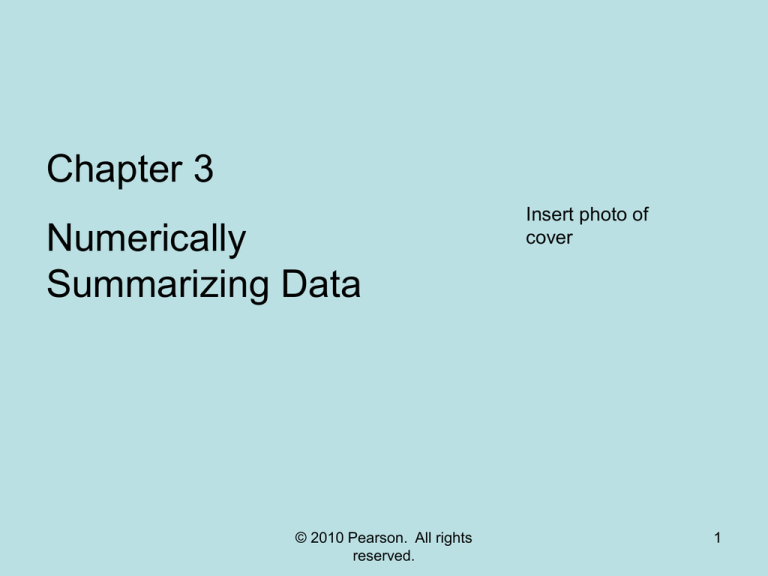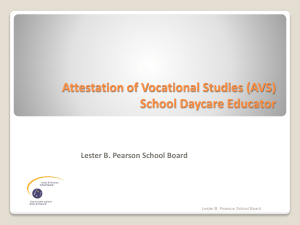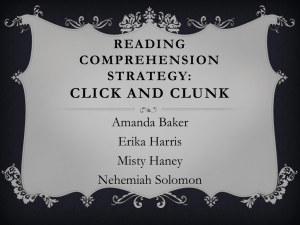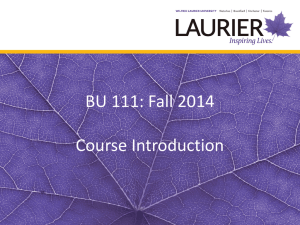
Chapter 3
Numerically
Summarizing Data
© 2010 Pearson. All rights
reserved.
Insert photo of
cover
1
Section 3.1 Measures of Central Tendency
Objectives
1. Determine the arithmetic mean of a variable from
raw data
2. Determine the median of a variable from raw data
3. Explain what it means for a statistics to be resistant
4. Determine the mode of a variable from raw data
© 2010 Pearson. All rights
reserved.
2
Objective 1
• Determine the arithmetic mean of a
variable from raw data
© 2010 Pearson. All rights
reserved.
3
The arithmetic mean of a variable is computed by
determining the sum of all the values of the variable in
the data set divided by the number of observations.
© 2010 Pearson. All rights
reserved.
4
The population arithmetic mean, is computed using
all the individuals in a population.
The population mean is a parameter.
The population arithmetic mean is denoted by .
© 2010 Pearson. All rights
reserved.
5
The sample arithmetic mean, is computed using
sample data.
The sample mean is a statistic.
The sample arithmetic mean is denoted by
© 2010 Pearson. All rights
reserved.
x.
6
If x1, x2, …, xN are the N observations of a variable
from a population, then the population mean, µ, is
x1 x2
N
xN
© 2010 Pearson. All rights
reserved.
7
If x1, x2, …, xn are the n observations of a variable
from a sample, then the sample mean, x , is
x1 x2
x
n
xn
© 2010 Pearson. All rights
reserved.
8
EXAMPLE
Computing a Population Mean and a Sample
Mean
The following data represent the travel times (in minutes)
to work for all seven employees of a start-up web
development company.
23, 36, 23, 18, 5, 26, 43
(a) Compute the population mean of this data.
(b) Then take a simple random sample of n = 3 employees.
Compute the sample mean. Obtain a second simple
random sample of n = 3 employees. Again compute the
sample mean.
© 2010 Pearson. All rights
reserved.
9
EXAMPLE
(a)
Computing a Population Mean and a Sample
Mean
x
i
N
x1 x2 ... x7
7
23 36 23 18 5 26 43
7
174
7
24.9 minutes
© 2010 Pearson. All rights
reserved.
10
EXAMPLE
Computing a Population Mean and a Sample
Mean
(b) Obtain a simple random sample of size n = 3 from the
population of seven employees. Use this simple random sample
to determine a sample mean. Find a second simple random
sample and determine the sample mean.
1
2
3
4
5
6
7
23, 36, 23, 18, 5, 26, 43
5 36 26
3
22.3
x
36 23 26
3
28.3
x
© 2010 Pearson. All rights
reserved.
11
© 2010 Pearson. All rights
reserved.
12
Objective 2
• Determine the median of a variable from
raw data
© 2010 Pearson. All rights
reserved.
13
The median of a variable is the value that lies in
the middle of the data when arranged in ascending
order. We use M to represent the median.
© 2010 Pearson. All rights
reserved.
14
© 2010 Pearson. All rights
reserved.
15
EXAMPLE
Computing a Median of a Data Set with an Odd
Number of Observations
The following data represent the travel times (in minutes)
to work for all seven employees of a start-up web
development company.
23, 36, 23, 18, 5, 26, 43
Determine the median of this data.
Step 1: 5, 18, 23, 23, 26, 36, 43
Step 2: There are n = 7 observations.
n 1 7 1
M = 23
4
Step 3:
2
2
5, 18, 23, 23, 26, 36, 43
© 2010 Pearson. All rights
reserved.
16
EXAMPLE
Computing a Median of a Data Set with an
Even Number of Observations
Suppose the start-up company hires a new employee.
The travel time of the new employee is 70 minutes.
Determine the median of the “new” data set.
23, 36, 27, 23, 18, 5, 26, 43, 70
Step 1: 5, 18, 23, 23, 26, 36, 43, 70
Step 2: There are n = 8 observations.
23 26
n 1 8 1
M
24.5 minutes
4.5
Step 3:
2
2
2
5, 18, 23, 23, 26, 36, 43, 70
M 24.5
© 2010 Pearson. All rights
reserved.
17
Objective 3
• Explain what it means for a statistic to be
resistant
© 2010 Pearson. All rights
reserved.
18
EXAMPLE
Computing a Median of a Data Set with an
Even Number of Observations
The following data represent the travel times (in minutes) to
work for all seven employees of a start-up web development
company.
23, 36, 23, 18, 5, 26, 43
Suppose a new employee is hired who has a 130 minute
commute. How does this impact the value of the mean and
median?
Mean before new hire: 24.9 minutes
Median before new hire: 23 minutes
Mean after new hire: 38 minutes
Median after new hire: 24.5 minutes
© 2010 Pearson. All rights
reserved.
19
A numerical summary of data is said to be resistant if
extreme values (very large or small) relative to the data do
not affect its value substantially.
© 2010 Pearson. All rights
reserved.
20
© 2010 Pearson. All rights
reserved.
21
EXAMPLE
Describing the Shape of the Distribution
The following data represent the asking price of homes
for sale in Lincoln, NE.
79,995
99,899
105,200
128,950
130,950
131,800
149,900
151,350
154,900
189,900
203,950
217,500
111,000
120,000
121,700
132,300
134,950
135,500
159,900
163,300
165,000
260,000
284,900
299,900
125,950
126,900
138,500
147,500
174,850
180,000
309,900
349,900
Source: http://www.homeseekers.com
© 2010 Pearson. All rights
reserved.
22
Find the mean and median. Use the mean
and median to identify the shape of the
distribution. Verify your result by drawing a
histogram of the data.
© 2010 Pearson. All rights
reserved.
23
Find the mean and median. Use the mean
and median to identify the shape of the
distribution. Verify your result by drawing a
histogram of the data.
The mean asking price is $168,320 and the
median asking price is $148,700. Therefore, we
would conjecture that the distribution is skewed
right.
© 2010 Pearson. All rights
reserved.
24
Asking Price of Homes in Lincoln, NE
12
10
Frequency
8
6
4
2
0
100000
150000
200000
250000
Asking Price
© 2010 Pearson. All rights
reserved.
300000
350000
25
True or False: The mean is resistant.
© 2010 Pearson. All rights
reserved.
26
True or False: The median is resistant.
© 2010 Pearson. All rights
reserved.
27
The following data represent the selling price
of a random sample of 10 homes in Joliet, IL.
Find the mean and the median. Which
measure of central tendency better describes
the “typical” selling price?
(a) Mean
(b) Median
(c) Not sure
© 2010 Pearson. All rights
reserved.
28
Objective 4
• Determine the mode of a variable from raw
data
© 2010 Pearson. All rights
reserved.
29
The mode of a variable is the most frequent
observation of the variable that occurs in the
data set.
If there is no observation that occurs with the
most frequency, we say the data has no
mode.
© 2010 Pearson. All rights
reserved.
30
EXAMPLE
Finding the Mode of a Data Set
The data on the next slide represent the Vice Presidents
of the United States and their state of birth. Find the
mode.
© 2010 Pearson. All rights
reserved.
31
© 2010 Pearson. All rights
reserved.
32
© 2010 Pearson. All rights
reserved.
33
The mode is
New York.
© 2010 Pearson. All rights
reserved.
34
Tally data to determine most
frequent observation
© 2010 Pearson. All rights
reserved.
35








